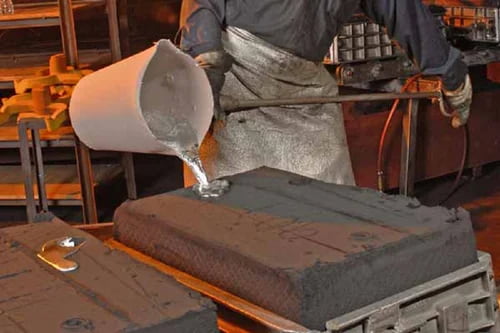

In an age where cutting-edge manufacturing methods like 3D printing, CNC machining, and high-pressure die casting dominate conversations, sand casting might seem like an old-school technique. Yet, this traditional process continues to play a critical role in modern engineering, especially when it comes to producing aluminum components.
From railway gear cases to energy infrastructure and defense-grade brackets, aluminum sand casting offers unmatched flexibility, cost-effectiveness, and design freedom for manufacturers worldwide. This article explores the sand casting process, the advantages of using aluminum, key industry applications, and how leading Indian manufacturers like Taural India are pushing the boundaries of this essential technology.
Sand casting is one of the oldest and most versatile metal casting processes. It involves creating a mold from sand, pouring molten metal into the mold cavity, and allowing it to solidify into the desired shape. Once cooled, the sand mold is broken apart, and the casting is removed.
While the fundamental principle has remained unchanged for centuries, modern sand casting integrates advanced tools and technologies, such as:
CAD modeling
Casting simulation software
Precision pattern-making
Controlled metallurgy
Automated mold handling
These innovations allow manufacturers to produce high-quality, high-performance aluminum castings that meet today’s engineering standards.
Aluminum is one of the most commonly used metals in sand casting, thanks to its excellent mechanical and physical properties, including:
Lightweight: Ideal for transportation and aerospace components.
Corrosion Resistant: Naturally forms a protective oxide layer.
Excellent Thermal & Electrical Conductivity: Widely used in power and energy sectors.
✅ High Strength-to-Weight Ratio: Suitable for structural and load-bearing applications.
✅ Easy to Machine & Finish: Reduces downstream processing time.
✅ 100% Recyclable: Environmentally friendly and sustainable.
These benefits make sand casting aluminium a go-to method for both functional engineering parts and aesthetic industrial components.
The aluminum sand casting process typically follows these steps:
Pattern Creation
A physical model (pattern) of the part is made from wood, plastic, or metal. This determines the mold cavity shape.
Mold Making
The pattern is pressed into a special sand mixture, which hardens to form the mold cavity. Molds are often made in two halves.
Core Insertion (if needed)
For hollow or complex internal geometries, sand cores are placed inside the mold.
Pouring
Molten aluminum is poured into the mold cavity.
Cooling
The aluminum solidifies inside the mold, typically within minutes depending on the part size.
Shakeout
Once cooled, the sand mold is broken away to retrieve the casting.
Cleaning & Finishing
Castings are trimmed, cleaned, and optionally heat-treated or machined to final specifications.
Sand casting supports components ranging from less than 1 kg to over 1000 kg, including highly complex shapes and internal cavities.
Unlike die casting or injection molding, sand casting uses inexpensive, reusable patterns, making it ideal for low to medium volume production.
Quick mold changes enable faster prototyping, perfect for R&D projects or customized one-off parts.
In addition to aluminum, sand casting supports a variety of other metals including bronze, brass, cast iron, and steel.
Sand molds are single-use, but the sand can often be reclaimed and reused, minimizing waste.
While it offers many advantages, aluminum sand casting does have some trade-offs:
Surface Finish: Typically rougher than pressure or investment casting; may require machining or polishing.
Dimensional Tolerances: Less precise; best for parts where ultra-tight tolerances are not critical.
Slower Production Rate: Each mold must be made individually, resulting in longer cycle times than permanent mold processes.
Aluminum sand castings are widely used across multiple sectors due to their adaptability and robustness.
Gear cases
Bogie brackets
Coupler components
Transformer housings
Switchgear enclosures
Turbine blades and cases
Structural brackets
Custom housing parts
Shock-resistant enclosures
Transmission housings
EV motor supports
Prototypes for product development
Ground support equipment
Non-flight critical components
Tooling and jigs
India is emerging as a global hub for metal casting, particularly aluminum sand casting, thanks to its combination of engineering talent, cost competitiveness, and industrial scalability.
One company leading this space is Taural India, headquartered in Pune. A joint venture with European leader Thoni Alutec, Taural India specializes in large, precision aluminum sand castings — with capacities up to 1000 kg per part.
Their capabilities include:
Full-cycle in-house production: Design, simulation, casting, machining, and testing
Sectors served: Rail, Energy, Defence, EVs, Aerospace
International quality standards with local manufacturing efficiency
For OEMs and Tier 1 suppliers looking for cost-effective, high-quality, and localized aluminum casting solutions, companies like Taural India are closing the gap between global demand and Indian capability.
Sand casting is the right choice when:
You need large, heavy, or complex parts.
Production volumes are low to medium.
Tooling budget is limited or needs to stay flexible.
Prototyping or customization is required.
Surface finish is not the top priority.
Despite being one of the oldest manufacturing processes, sand casting aluminum remains a relevant, powerful, and economical solution for a wide range of modern applications.
Its ability to deliver custom, large-scale, and complex parts at a reasonable cost makes it a preferred choice for critical industries — from infrastructure and mobility to defense and energy.
As Indian manufacturers like Taural India continue to advance the process with automation, simulation, and quality control, aluminum sand casting is no longer just traditional — it’s transformational.